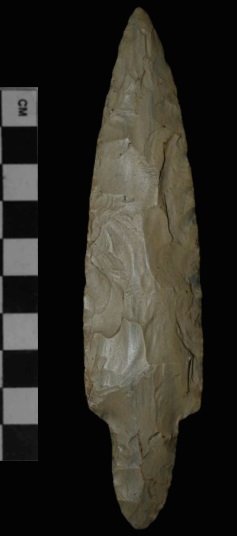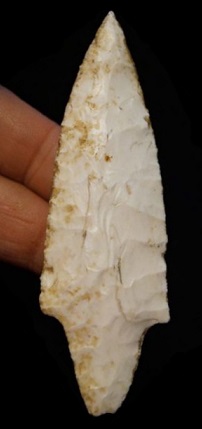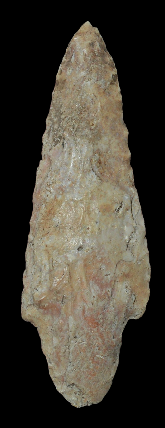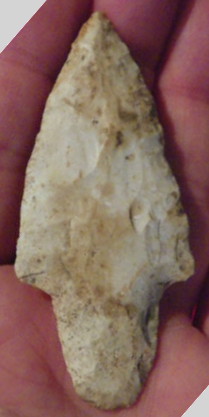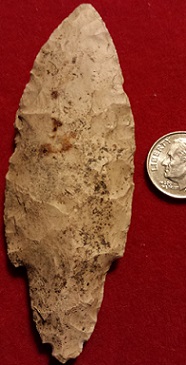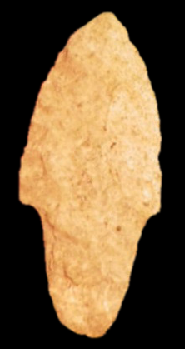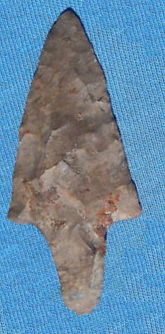Outline is Representative of Size and Shape:
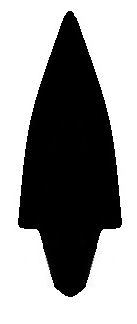
Name Details:
Identified By: David Baerris (named) / Robert Ritzenthaler (formalized
Named For: Lake Waubesa, Wisconsin
Date Identified: 1953 / 1967
Type Site: Blackhawk Village Site (Da5), Waubesa Lake, Dane County Wisconsin
Identified By: David Baerris (named) / Robert Ritzenthaler (formalized
Named For: Lake Waubesa, Wisconsin
Date Identified: 1953 / 1967
Type Site: Blackhawk Village Site (Da5), Waubesa Lake, Dane County Wisconsin
Point Validity: Valid Type
Baerris is a well published Anthropologist and was a professor at the University of Wisconsin-Madison. Ritzenthaler was a distinguished anthropologist and Curator of Anthropology at the Milwaukee Public Museum. He served as an Officer and Editor for the Wisconsin Archaeological Society. This type was named in a professional publication and has many professional references. This is considered a valid type.
Waubesa Contracting Stem
AKA: Dickson Broad Blade Variant, Adena Waubesa,
Beavertail
Cluster:
Description of Physical Characteristics and Flaking Pattern:
This is a thick medium to large (2 to 5 inches) triangular to lanceolate contracting stem point with an elliptical cross section. The blade is elongated and excurvate with the widest portion of the blade commonly at the shoulders. The shoulders are primarily horizontal, but may be slightly barbed to having an upward angle. The stem is long and contracting with a base that may vary from convex or “beaver tail” to pointed. Basal grinding as absent on this type. This point is manufactured using random percussion flaking with pressure flaking used to trim and retouch the blade forming a random flaking pattern.
Size Measurements:
Length - 60 to 152 mm (101 mm average), Stem Length - 15 to 30 mm, Blade Width - 30 to 40 mm, Stem Width at Shoulders - 12 to 20 mm
Length - 60 to 152 mm (101 mm average), Stem Length - 15 to 30 mm, Blade Width - 30 to 40 mm, Stem Width at Shoulders - 12 to 20 mm
Commonly Utilized Material:
Local cherts and silicified sandstones, Heat treated Burlington Chert, Crescent Chert and Hixon Silicified Sandstone (southern Iowa and into Illinois and Missouri). Dover Chert (Tennessee), and Hornstone (Indiana).
Local cherts and silicified sandstones, Heat treated Burlington Chert, Crescent Chert and Hixon Silicified Sandstone (southern Iowa and into Illinois and Missouri). Dover Chert (Tennessee), and Hornstone (Indiana).
Additional Comments:
This type is a variant of the Dickson point. These points are generally smaller with bases that are more pointed than commonly seen on Dickson points (Boszhardt, 2005). This type is often incorrectly associated with the Adena culture and points due to overlapping characteristic with the Adena type. However, this point is associated with the Hopewell culture, not the Adena culture.
These points have been dated at 2,500 to 1,800 B.P., but may be more restricted in age dating from 2,100 to 1,900 B.P. These points have been reported found in association with Black Sands ceramics, but these points may represent older (and related) Belknap points which are diagnostic of the Black Sands phase (Boszhardt, 2005). However, Howell, (2001), argues that Waubesa points are diagnostic of the Black Sands culture in western Wisconsin.
These points are found in association of, and considered an alternate variation of the Dickson point. Winters felt that that these represented a knife form of the Dickson point. Boszhardt (2005), feels that these are quickly made expendable points designed for quick removal and replacement of the projectile from the main shaft.
The Adena and Waubesa points have many overlapping similarities. Adena points have less defined shoulders and has the widest part of the blade well above the shoulders. Waubesa points have well defined shoulders with the widest part of the blade at the shoulders (Morrow, 2016)
This type is a variant of the Dickson point. These points are generally smaller with bases that are more pointed than commonly seen on Dickson points (Boszhardt, 2005). This type is often incorrectly associated with the Adena culture and points due to overlapping characteristic with the Adena type. However, this point is associated with the Hopewell culture, not the Adena culture.
These points have been dated at 2,500 to 1,800 B.P., but may be more restricted in age dating from 2,100 to 1,900 B.P. These points have been reported found in association with Black Sands ceramics, but these points may represent older (and related) Belknap points which are diagnostic of the Black Sands phase (Boszhardt, 2005). However, Howell, (2001), argues that Waubesa points are diagnostic of the Black Sands culture in western Wisconsin.
These points are found in association of, and considered an alternate variation of the Dickson point. Winters felt that that these represented a knife form of the Dickson point. Boszhardt (2005), feels that these are quickly made expendable points designed for quick removal and replacement of the projectile from the main shaft.
The Adena and Waubesa points have many overlapping similarities. Adena points have less defined shoulders and has the widest part of the blade well above the shoulders. Waubesa points have well defined shoulders with the widest part of the blade at the shoulders (Morrow, 2016)
Distribution: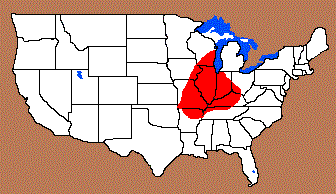
Distribution Comments:
These points are most commonly found in the Ohio River valley and Upper Mississippi River Valley.
These points are most commonly found in the Ohio River valley and Upper Mississippi River Valley.
Age / Periods:
Date: 2,500 - 1,800 B.P.
Cultural Period: Woodland
Glacial Period: Neoglacial to Roman Warm
Culture: Black Sand and Havana Hopewell cultures
Date: 2,500 - 1,800 B.P.
Cultural Period: Woodland
Glacial Period: Neoglacial to Roman Warm
Culture: Black Sand and Havana Hopewell cultures
Age Details:
These points are found in association with Prairie ware ceramics and are diagnostic of the Prairie phase (Stoltman, 1990)
These points are found in association with Prairie ware ceramics and are diagnostic of the Prairie phase (Stoltman, 1990)

